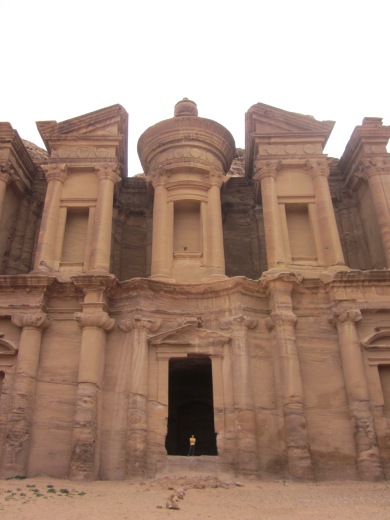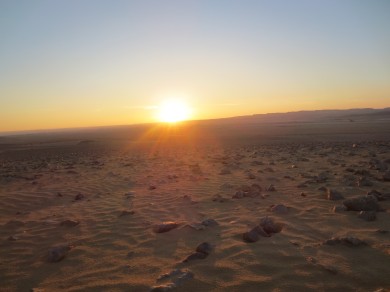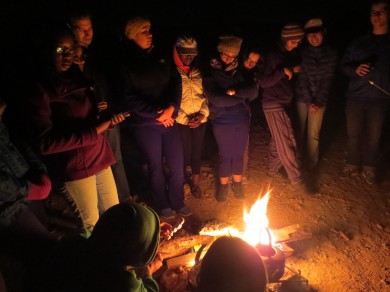On Friday, we ended this amazing academic voyage with two absolutely inspirational speakers. I drew an interesting connection between our morning speaker, retired General Mansour Abu Rashid of Amman Center for Peace and Development, and our afternoon speaker, Madian Al-Jazerah of Books@Cafe. Madian told us about how he and other Jordanian disenfranchised populations were constantly on the run from the ministry of intelligence. By stark contrast and quite ironically, General Abu Rashid was formerly the head of intelligence for Jordan. Although the timing of their careers makes it unlikely that these two individuals ever were directly nemeses, for me it shed light on an important truth: there are blurred lines between good and evil, and two people’s perceptions of good can easily be at odds with one another.
If one speaker’s good could be another speaker’s evil, then the dichotomy of good and evil that was ingrained into us at an early age through Disney movies and other such stories implodes. Today, I think it’s more important than ever to tell ourselves and our teach our children a truer narrative, one that recognizes that every human (as well as every societal group) is his own special mix of good and evil, that this mix is always changing, and that any interpretation of someone’s good or evil depends pretty heavily on who is making the judgment.
When I saw Jordanians at the market or on the street I saw their humanity. I saw good people striving to make a living for their families and just trying to enjoy life. These people could be the heroes in a movie. But statistically speaking, it sounds like some of them are anti-Semitic, anti-Israel, and/or homophobic. To many people in the world, that’s evil. Israel mirrors this, too. With everything astounding about Israeli society from being able to turn the desert green, innovate and be the first democratic government in the Middle East, it could also be a hero in a narrative (as it is in every Birthright trip). But we saw the horrible human toll of its Occupation of Palestine has taken up close and personal when we heard the stories of Israeli and Palestinian parents who lost loved ones to the conflict. What about the psychological trauma one must undergo from living their whole life under Occupation? The strength of spirit it must take to choose peace and reconciliation over retaliation and revenge was another example of how a battle between good and evil was playing out within a person, with good eventually triumphing.
Madian seemed to understand this internal interplay of good and evil. While he told his own story in a way that made him to be a hero, he at one point said the words, “I am corrupt.” It was in the context of the strategies and tactics he used. To me, though, it showed a large amount of humility and self-awareness on his part that even the Harriet Tubman of Jordan understands he has his character flaws, that he gets there is some evil within his good.
I spent a lot of time on this trip reflecting on these ideas of good and evil. Actually, I explored this topic in our first group reflection. It was after our day at Yad Vashem. While I had a deep, spiritual experience at Yad Vashem and I think it’s probably the best-run museum I’ve been to, I also noted that they left out an important piece of the puzzle. To many Westerners, the Holocaust represents the epitome of evil done on a societal scale, and Yad Vashem is our doorway into the darkest depths of human capacity for evil. One of the tour guide’s goals appeared to be putting us in the shoes of the Jewish victims and survivors through telling their personal stories and literally showing us their shoes. However, this is an incomplete story. Because if the goal of Yad Vashem is truly “Never Again” then they should also put us in the shoes of the German Nazi perpetrators. A lot of academic research has been done as to how regular German people over time could come to commit such horrible atrocities and a lot of it came down to fear and dispersion of responsibility. Most academic research such as the Stanley Milgram experiment points to a sad, dark truth that any of us would likely have acted similarly if we were born as Germans during that period. Moreover, our professor made the case that in large groups we regularly discard our better moral judgment and remain silent or even participate directly in injustices when the economic and social incentives reward it and a dispersion of responsibility dissolves accountability.
Once we can come to terms with the capacity for evil within each of us we can reject the dangerous Western logic of us being good and others being evil. Once we do this, we’re already half way to world peace. Every person has the ability to change himself and his immediate society much more so than he can change some distant evil. And when others see you fixing your wrongdoings they’re more likely to fix their own.
A case example for me is the fact that even as we mourn and honor the stories and lives of Holocausts victims and survivors with the phrase, “Never Again,” we as a society have allowed genocide to occur again right under our noses, remaining silent. In the mid 2000’s in Darfur, Sudan, hundreds of thousands of people were systematically murdered by the Sudanese government. The United States Congress officially named it a genocide, and yet it persisted for many years as the death toll multiplied. Every one of us had real power to help end the genocide in Darfur, but unfortunately we as a society largely remained silent.
Genocide is an extreme example, but I think a similar principal underlies a lot of social injustice in the world – climate change, racism, sexism, homophobia, and poverty. Often large injustices are the accumulation of innumerable smaller injustices that we have the power to easily change if we take the approach of focusing on ourselves and our immediate communities first.
The fact that there are so many problems plaguing society and so many entry points to fix them is the reason why I’m on my personal path of social entrepreneurship. Hopefully, it’s why everybody else is on this trip as well. We all have a call to action, a unique opportunity to make a difference. Understanding how we’re part of injustices makes them easier to change.
-Ben S.







